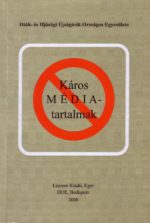Leírás
Figyelem: Már csak utolsó példányok rendelhetők!A 20. századi média, a 20-21. századi informatikai társadalom, az internet, a mobilkommunikáció világának a vizsgálói megállapították, hogy ,ikonikus fordulat előtt állunk. Ennek a fordulatnak egyik jól tanulmányozható és az internetes közleményben, sms-ben sikeresen használható megjelenítője az emotikon (érzelemjel, vagy smiley: mosolyikon, mosolykód). Az emotikonok múltja is messze visszavezethető a művelődéstörténetben. Az írásbeliség alakulásakor többször fölötlött további, például a zenei leíráshoz hasonlatos képszerű jelek (ikonok) bevezetésének a gondolata. Amit akkor a kor értelmisége, írásbeliségnek kialakítói nem fogadtak el, az. A 20. század végén spontán módon bevezették az internetezők és az sms-ezők.
Mobilszolgáltatók már korábban is publikáltak emotikonszótárakat. Ezekben keverednek az egyéni ötletek (idiolektusok) és a közösségileg elfogadott formák (szociolektusok). Most a nemzetközi és magyar szemiotikában, írástörténetben, írásjeltörténetben páratlan munka született magyar nyelven. Két fiatal nyelvész, Bódi Zoltán és Veszelszki Ágnes a Magyar Szemiotikai Társaság kiadványsorozatában jelentették meg az Emotikonok. Érzelemkifejezés az internetes kommunikációban című könyvüket.
Az első ikon (mosolyikon) már a digitális írásbeliség előtt megszületett. A mosolygós arcot, a smiley-t a londoni Franklin Loufrani 1968-ban jegyeztette be. Később pólók, bögrék és egyéb tárgyak díszítésére használták. Az 1990-es évek elején a smiley az acid house zene és kultúra jelképe lett. Használati körének a bővülését betri- ós írásjelkarakterek, majd pedig képfájlok bevonulásával az internetes írásbeliségnek, kultúrának köszönheti. Az emotikonok tehát az elsődleges írásbeliség, annak írásjeleiből nőttek ki, és lettek a másodlagos írásbeliség jelei. Az első emotikon, vagyis a mosolyikon valódi írásjelekből áll: kettőspontból és zárójelből, és érdekessége, hogy ha 90 fokkal balra fordítjuk, akkor fenn van a két pont és alatta a zárójel, amely valójában a szemet és a mosolygó arcot formázza. Ez az emotikon tehát egyértelműen az ember talán legfontosabb mimikai, érzelmi kommunikációjának, a mosolynak ikonikus (képszerű) jele. Vannak azután bonyolultabb ikonikus formák, ilyen pl. a virágszál figuratív ábrája (ami még ikon, mert felismerhető): @ – } – Ha talpára állítjuk, valóban virágszál! Ám lehetséges ugyanilyen technikával szimbolikus (nyelvi) üzeneteket is alkotni. Ez azonban ritkább. Emotikon-szimbólumoknak nevezhetnénk őket. A magyarországi mobiltelefon-szolgáltatok meg is jelentettek kis emotikon (sms-)szótárakat, amelyekben ilyen jeleket találunk: %-6 – agyilag zokni vagyok (’teljesen ki vagyok merülve),
Ahogy a technika fejlődött, az említett emotikonok elkezdtek képpé válni, mozogni, átalakulni, s létrejött a dinamikus emotikon vagy animotikon (teljességgel magyar szakirodalomban született elnevezések). De ha már megjelentek a mozgó, dinamikus emotikonok, akkor az addigi, mozdulatlan emotikonokat is megneveztük. Ezek lettek a statikus emotikonok. A dinamikus emotikonok nem csupán kettőspont-kötőjel-zárójel karakterekből építkeznek, hanem színes mozgóképekből (gif- vagy png-formátumú képfájl). Ezek is leginkább arcokat mutatnak, de lehetnek pl. állatfigurák is.
A jelenség páratlan szemiotikai érdekessége az, hogy az emberi kultúrában legfejlettebbnek gondolt alfabetikus írás ezekkel a jelekkel voltaképpen visszatér(t) az írásfejlődés kezdetéhez, a hieroglif íráshoz. Ugyanis a hieroglifa tekinthető piktogramos (azonosítható képet tükröző ikonnak/szimbólumnak). A másik érdekessége az, hogy a mai alfabetikus írásrendszerünk alakulásakor többször fölmerült ilyen formák felvétele. Tulajdonképpen egyfajta emotikonnak tekinthető a felkiáltó jel (!), a begörbüléssel is kétkedést mutató kérdőjel (?) vagy a megszakadást mutató három pont (…). Amit eleink elmulasztottak, azt most a másodlagos írásbeliség (ez is a mi meghatározásunk), azaz az informatikai eszközökön terjedő sajátos, beszédközeli írásmód spontán módon, a folklór törvényszerűségeihez igazodva bevezeti, elterjeszti, sőt, az elsődleges írásbeliségbe (hivatalos írásbeliség, amelynek van helyes írása, hivatalosan elfogadott szabályrendszere) is átviszi.
Az emotikonlexikonok a jeleket leginkább tematikusan csoportosítják: pl. öröm, szomorúság, csodálkozás, kínos, szerelem, akciók, megjelenés, személyjellemzők, ivászat, étkezés, szünidő stb. Bódi Zoltán kutatásaiban az emotikonok a következők jelzésére alkalmasak: indulat, boldogság, türelmetlenség, elégedetlenség, vidámság, szomorúság, gúny. A dinamikus emotikonok képi jellemzőinek bemutatása után Veszelszki Ágnes tematikai és funkcionális csoportosítást ad: érzelmek,általános cselekedetek, szexualitás-erotika, agresszió, humor, kapcsolattartás és ünnepek, figurák, írásjelek. A kötethez előfordulási gyakoriságot mutató emotikonszótár és a dinamikus emotikonok négyoldalas színes animált sorozata járul. Aki pedig mozgásban akarja megcsodálni ezeket a kis ,filmeket, a kötethez mellékelt CD-n is megtalálja őket.
Bódi Zoltán kvantitatív felméréseket is végzett a statikus emotikonokkal kapcsolatban. Például megvizsgálta az átlagos smiley-gyakoriságot, amelyből kiderült, hogy a teljes szöveganyagnak a felében nem használnak emotikont. Ám akik használnak, azok természetesen többet és többször is alkalmazzák. Érdekes az a felmérés is, hogy miként fejezik ki az adatközlők az indulatukat. A felmérés korpusza szerint 30-30%-ban szövegesen vagy smiley-val, 16% felkiáltójelek halmozásával, 1 -1% csupa nagybetűvel, illetve vegyes jelekkel+szövegekkel. Viszont a boldogságot már 94% fejezi ki smiley-val, a vidámságot 96%, a szomorúságot 97%… Bódi Zoltán a statikus emotikonok kvantitatív bemutatása mellett elvégzi ezeknek a szemantikai és szintaktikai leírását is. A szemantikai leírás tartalmazza az érzelemkifejezés jellegét. A szintaktikai leírás pedig a jelváltozatok megvalósítását (és statisztikáját Például az utóbb említett szomorúság-ikonnak a következő változatai lehetnek (gyakorisági sorrendben, a leggyakoribbtól haladva a kevésbé gyakoriig):
Veszelszki Ágnes ugyancsak végzett empirikus felmérést az MSN Messenger programjában használt dinamikus (mozgó) emotikonokról. Vizsgálja a dinamikus emotikonok szinét, méretét, a felbukkanó tárgyakat, kellékeket, cselekvéseket (pl.: tisztálkodás, étkezés, szórakozás, számítógépezés, szív). Azután vannak olyan dinamikus emotikonok, amelyek szóbuborékokkal vagy táblákkal vannak kiegészítve (textuális emotikonoknak nevezi őket). Az animált emotikonok gyakran élnek a rajzfilmekből ismert túlzásokkal (a smiley szeme óriásivá nő, égnek áll a haja stb.). Természetesen ezek a cselekvésemotikonok narrációt (elbeszélést) is tartalmaznak (ilyen pl. az udvarlásra való felkészülést mutató animotikon). A kötetben található emotikonszótár az érzelemkifejezés tematikus rendjében tartalmazza az emotikonokat, majd pedig négy színes oldalon a dinamikus emotikonokat (illetve azok sorozatát). Természetesen az emotikonok világa az élő nyelvhez és a folklórhoz hasonlóan folyamatosan változik, alakul. Ezért a gyűjtemény a magyarországi felbukkanástól (kb. 1996-tól) a 2006-ig terjedő időszakra vonatkozik. Egy újabb évtized elteltével valószínűleg ismét nagy ,ugrás történik, s e szótár új fejezetekkel bővülhet.
A páratlan munka voltaképpen egy új kifejezési-árnyalási mód fölfedezése és leírása. Ha túlozni akarnék: egy régi kommunikációs forma új közegben való újjászületésének, kiterjesztésének a dokumentálása. (Balázs Géza)
A review by Géza Balázs: Emoticons/emotion icons
Zoltán Bódi – Ágnes Veszelszki: Emoticons – Expressing emotions in the internet communication. Hungarian Association for Semiotic Studies. Budapest. 2006. Hungarian Semiotical Studies, vol. IX. 142 pages + supplementary CD.
Researchers of the 20th century media, the 20-21st century informational society, the world of internet and mobile communication observed that we are about to take an ‘iconical turn’. A clearly observable and very practical representative of this turn is the emoticon (smiley, smile icon, emotion icon or emotional iconization). Emoticons, however, have deep roots in cultural history. Initiating pictorial marks (icons) such as in musical transcription has been a frequently mentioned idea in the history of literacy. What the intellectual class of the era (who had a role in shaping the writing tradition) had not accepted then, the internet and SMS-users initiated in a spontaneous way at the end of the 20th century.
Mobile companies have already published emoticon dictionaries that contain mixtures of individual ideas (idiolects) and commonly accepted forms (sociolects). Recently, however, a Hungarian study has been published on the topic that is unparalleled in the international and Hungarian semiotic studies as well as in the history of literacy and graphemes. Emoticons – Expressing emotions in the internet communication was written by two young linguists, Zoltán Bódi and Ágnes Veszelszki, and was published by the Hungarian Association for Semiotic Studies as a new member in its series of semiotic publications.
The first icon (smile icon) was created well before the digital literacy. The smiling face (the smiley) was registered as a trademark by its inventor Franklin Loufrani in 1968. Later on it appeared on T-shirts, mugs and other items, while in the beginning of the 1990s the smiley became the symbol of acid house music and culture. Its scope of use broadened owing to the digital literacy and culture, which featured an inventive application of the existent graphemes, keyboard characters and later on image files. Emoticons, therefore, stem from the graphemes of primary literacy but have become the marks of secondary literacy.
The first emoticon, i.e. the smiley, was consisted of real graphemes (more precisely punctuation marks): a colon and a bracket. Its curiosity is that if rotated 90 degrees clockwise, the colon comes atop and the bracket below, thus depicting the two eyes and an ear-to-ear smile. Clearly, this emoticon is the iconical (pictorial) sign of the smile, which is one of the most important signs in the emotional, mimical communication of man. Furthermore, there are more complex iconical forms, like the figurative image of the flower (which is an icon, because yet recognisable) : @-}- By making it stand, indeed, it is a flower! Moreover, with the very same ‘technique’, it is possible to coin up symbolical (lingual) messages. These icons (might as well be called emoticon-symbols) are, however, less frequent phenomena. As mentioned above, Hungarian mobile companies have published smaller emoticon (and SMS-) dictionaries featuring symbols like: %-6 – ‘braindead’ (thoroughly exhausted),
With the development of technology, these emoticons could change shape, become small pictures and be animated, this way evolving to dynamic emoticons or animoticons (labels first used in the Hungarian terminology). With the naming of the animated, dynamic emoticons, we could retrospectively name the unanimated, motionless emoticons as well: these are the static emoticons. The structural constituents of dynamic emoticons are not any more just colons, hyphens and brackets, but lively colourful animated image files (gif or png formatted image files). The majority of these emoticons continue to depict facial expressions but we can come across e.g.: small animals as well.
The outstanding semiotic curiosity of the phenomenon is that the alphabetic writing system, which is considered to be highly developed, revisited an earlier stage in the history of literacy, i.e. the hieroglyph writing. Since a hieroglyph reflects an identifiable image, it can be regarded as a pictogramic icon or symbol. Another curiosity of the phenomenon is that the idea of completing the alphabet with such symbols turned up from time to time in the history of literacy. In fact the exclamation mark (!), the question mark (?) with its curve expressing doubt or the three dots (…) signifying interruption may also be considered as emoticons. What our predecessors had refused to do, the secondary literacy (also Hungarian terminology) has done in a spontaneous, speech-like way that uses the latest technological means of communication but keeps to the folklore traditions nevertheless. Secondary literacy not only began to use and spread its new symbols, but it also shifts them to the primary literacy (official literacy with standard forms and generally accepted system of rules).
Emoticon lexicons give thematic classifications of these symbols: e.g. happiness, sadness, amusement, embarrassment, love, actions, outlook, personal characteristics, carousal, eating, holiday, etc. According to the researches of Zoltán Bódi, emoticons can signify the following states of mind: aggression, pleasure, impatience, discontentment, happiness, sadness, sarcasm. After describing the visual characteristics of dynamic emoticons, Ágnes Veszelszki gives a thematic and functional classification: emotions, general activities, sexuality – eroticism, humour, human relations and holidays, figures and punctuation marks. The book contains an emoticon dictionary featuring the frequency rate of each item and a colourful presentation of dynamic emoticons on four pages. The collection of these small movies is available in motion on the supplementary CD.
Zoltán Bódi carried out quantitative surveys on static emotions. For instance he had examined the average smiley frequency, which showed that emoticons were missing from the half of the examined texts, but where they appear, people use more of them and more often. It is also interesting to see how the participants of the surveys express their passion. According to the corpus: 30-30% express themselves textually or via smileys, 16% by overusing exclamation marks and 11-11% by ‘writing with the caps lock on’ or using a mixture of texts and marks. However, 94 out of 100 uses smiley to express pleasure, 96 to express happiness and 97 to sadness.
Beside demonstrating them, Zoltán Bódi also gives a semantic and syntactic description of the static emoticons. The semantic description highlights the manner of expressing emotions, while the syntactic description covers the realisation (and statistics) of the sign variations. The above mentioned ‘sadness icon’, for example, occurs in the following variation (in order of frequency, from the most to the least common):
Ágnes Veszelszki had also carried out an empirical survey on dynamic (animated) emoticons used in MSN Messenger program. She examines the colour and size of emoticonism the occurring items, accessories, activities (e.g. hygiene, eating, entertainment, using the computer, heart). In addition, there are dynamic emoticons supplied with speech bubbles or banners (they call them textual emoticons). The animated emoticons often contain comic-like exaggerations (the smiley’s eyes bulge, his hair stands on end, etc.). Naturally, these activity emoticons present stories (narratives) like getting prepared to a date.
The emoticon dictionary included in the book, list the emoticons in the thematic order of expressing emotions, which is followed by a four-page-presentation of the dynamic emoticons (series of pictures). Evidently, the world of emoticons constantly changes and improves similarly to the living language and folklore, so, the collection covers only the period of time from approximately 1996 to 2006. In a decade’s time we can count on a subsequent ‘leap’ in our writing tradition, and further chapters may be added to the dictionary.
In fact, what this unparalleled publication discovers and describes, is a novel manner of expressing ourselves. With a bit of exaggeration: it documents the rebirth and extension of an old communicational form in new environment. English translation: Levente Nagy [2006.11.08.]





Értékelések
Még nincsenek értékelések.